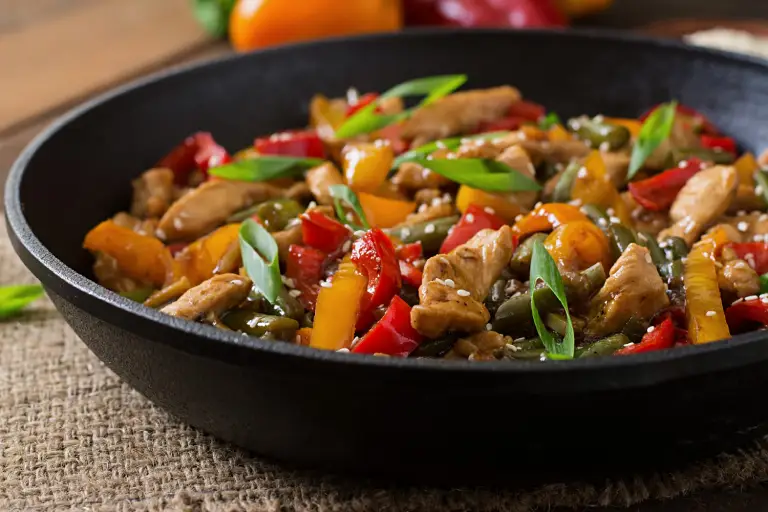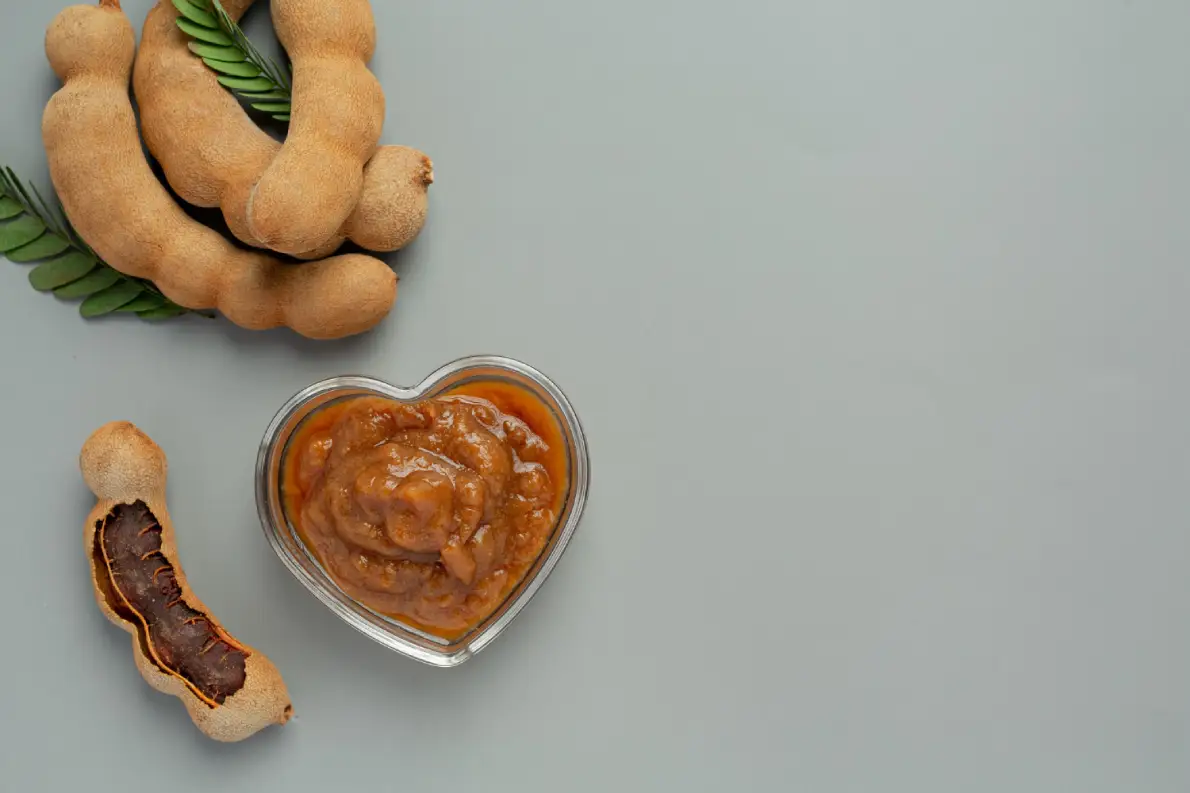In the culinary world, a myriad of flavors and ingredients come together to create dishes that tantalize our taste buds and enrich our dining experiences. Among these, tamarind sauce stands out as a versatile and intriguing condiment that adds a unique blend of sweet, sour, and tangy flavors to a variety of dishes. This article dives deep into the essence of tamarind sauce, exploring its origins, how to make it, its nutritional benefits, and its myriad uses in cooking. So, buckle up, and let’s embark on this flavorful journey together!
If you like try this Easy Homemade Tamarind Sauce Recipe, Salmon Poke Bowl Recipes and corned beef seasoning.
Introduction to Tamarind Sauce
Tamarind sauce, a condiment that dances on the palate with its complex flavors, has been a culinary treasure across the globe. This delightful sauce, derived from the fruit of the Tamarindus indica tree, is a staple in many kitchens, offering a perfect balance of sweetness, sourness, and a hint of spice. But what exactly is this intriguing sauce, and why has it captured the hearts of food enthusiasts everywhere?
What is Tamarind Sauce?
At its core, tamarind sauce is a thick, smooth concoction made from the pulp of tamarind fruit. This pulp is extracted, often mixed with water, and then combined with various ingredients such as sugar, salt, and spices to create a rich, flavorful sauce. The result? A versatile condiment that can elevate the simplest of dishes to something truly extraordinary.
Brief History and Origin
Tracing its roots back to Africa, tamarind has journeyed across oceans and continents, finding a home in the cuisines of Asia, the Middle East, Latin America, and the Caribbean. Each culture has embraced tamarind, incorporating it into their culinary traditions in unique and innovative ways. From Indian chutneys to Thai soups and Mexican candies, tamarind sauce has become a global phenomenon, beloved for its ability to add depth and complexity to dishes.
Culinary Uses Worldwide
The beauty of tamarind sauce lies in its versatility. It’s not just a condiment; it’s a culinary chameleon, adapting to and enhancing the flavors of various dishes. In Indian cuisine, it’s often found in tangy chutneys and savory dishes like samosas. Move over to Thailand, and you’ll discover it adding a sour punch to Pad Thai. In the Caribbean, it’s used to create mouthwatering marinades for meats. And let’s not forget its role in creating the iconic Worcestershire sauce, which adds a zesty kick to recipes around the world.
Making Tamarind Sauce
Roll up your sleeves and get ready to dive into the art of making tamarind sauce from scratch. This journey from fruit to sauce is simpler than you might think and oh-so-rewarding. Let’s break it down into easy steps, ensuring you can whip up this culinary masterpiece with ease and confidence.
Ingredients Needed
To embark on this saucy adventure, you’ll need:
- A 200g block of tamarind pulp
- Water, enough to cover the pulp (about 1 ½ cups, plus more if preferred)
- 1 teaspoon of cumin powder
- 1 teaspoon of chaat masala (optional, but it adds a nice kick)
- ½ teaspoon of dried ginger powder
- ½ teaspoon of red chilli powder (or to taste)
- 1 tablespoon of sugar or jaggery – adjust to your sweetness preference
- Salt, to taste
Gathering these ingredients is the first step in creating a sauce that’s bursting with flavor and complexity.
Step-by-Step Recipe
- Prep the Tamarind: Begin by breaking the tamarind block into about six chunks. Place these in a small saucepan and cover with water. This is where the magic starts to happen.
- Cook the Tamarind: Bring the water to a rolling simmer over medium-high heat, stirring often. After about 5 minutes, remove from the heat and let it cool slightly. This process helps to release all the flavors and soften the pulp.
- Extract the Pulp: Using a wooden spoon or potato masher, smash the softened tamarind in the water. Aim for a consistency that’s thick like ketchup. Then, strain this mixture through a sieve into a bowl, pressing against the solids to extract as much liquid as possible. Discard the solids.
- Final Touches: Return the strained tamarind paste to the saucepan. Stir in the cumin, chaat masala (if using), ginger, chilli powder, sugar, and salt. Bring the mixture to a simmer for about 3 minutes until the sugar dissolves completely. If you prefer a thinner sauce, feel free to add a bit more water.
And voilà! You’ve just made homemade tamarind sauce. This sauce can be stored in a convenient squirt bottle or jar in the fridge, ready to add a burst of flavor to your dishes.
Variations and Customizations
The beauty of making tamarind sauce at home is the freedom to tailor it to your taste. Fancy it sweeter? Add more sugar or jaggery. Craving a bit more heat? Sprinkle in some extra chilli powder. The possibilities are endless, and the best part is, you can adjust the flavors as you go.
This homemade tamarind sauce not only surpasses store-bought versions in taste but also allows you to add a personal touch to your cooking. Whether you’re drizzling it over savory snacks, mixing it into marinades, or using it as a dipping sauce, this versatile condiment is sure to impress.
Stay tuned, as we continue to explore the wonders of tamarind sauce, including its health benefits and culinary applications. The journey into the tangy, sweet, and spicy world of tamarind is far from over!
Culinary Applications
Diving into the culinary world of tamarind sauce, we uncover its role as a dynamic and versatile player in the kitchen. This tangy condiment doesn’t just accompany dishes; it transforms them, adding layers of flavor that can turn the ordinary into the extraordinary. Let’s explore how to pair this delightful sauce with foods, enhancing every bite with its unique blend of sweet, sour, and spicy notes.
Traditional Dishes with Tamarind Sauce
In the realm of traditional cuisine, tamarind sauce is a star. It’s not just a sidekick but often the main event in dishes that have been cherished for generations.
- Samosas and Poppadoms: Imagine biting into a crispy samosa, its savory filling complemented by the tangy sweetness of tamarind sauce. Or consider the crunch of poppadoms, elevated with a dollop of this sauce.
- Pad Thai: This Thai classic owes its distinct flavor profile to tamarind sauce, which balances the dish’s sweetness and saltiness with a touch of sour.
- Indian Chaats: Street food at its finest, chaats are incomplete without a generous drizzle of tamarind sauce, adding a burst of flavor that’s hard to resist.
Innovative Recipes and Pairings
While traditional dishes showcase tamarind sauce in its element, don’t hesitate to get creative and experiment with new pairings.
- Grilled Meats and Vegetables: Brush tamarind sauce over grilled meats or vegetables for a caramelized, tangy glaze that’s sure to impress.
- Salad Dressings: Whisk it into salad dressings for a fruity twist that will liven up any greens.
- Desserts: Yes, desserts! A small amount of tamarind sauce can add an intriguing flavor to sweet dishes, especially those featuring tropical fruits.
Tips for Cooking with Tamarind Sauce
To fully harness the power of tamarind sauce in your cooking, keep these tips in mind:
- Balance is Key: Tamarind sauce is potent, so start with a small amount and adjust to taste. Its acidity and sweetness can overpower dishes if not used judiciously.
- Complement the Flavors: Think of the other elements in your dish. Tamarind pairs well with ingredients that can stand up to its bold flavors, such as spicy chilies, sweet coconut, and robust spices.
- Experiment: Don’t be afraid to try tamarind sauce in unexpected dishes. Its versatility might surprise you, adding depth and interest to both savory and sweet creations.
Tamarind sauce, with its complex flavor profile, invites us to explore the endless possibilities it brings to the table. Whether you’re sticking to traditional recipes or venturing into new culinary territories, this sauce is a gateway to a world of flavor. So, go ahead, let your taste buds lead the way, and discover the myriad ways tamarind sauce can transform your cooking. The adventure is just beginning!

Best recipes of tamarid sauce
Tamarind Glazed Salmon
Ingredients:
- 4 salmon fillets
- 2 tablespoons tamarind sauce
- 1 tablespoon honey
- 1 tablespoon soy sauce
- 1 garlic clove, minced
- Salt and pepper to taste
- Olive oil
Instructions:
- Preheat your oven to 375°F (190°C).
- In a bowl, mix the tamarind sauce, honey, soy sauce, and minced garlic. Stir until well combined.
- Season the salmon fillets with salt and pepper. Brush them with olive oil and place them on a baking sheet lined with parchment paper.
- Generously brush the tamarind mixture over the salmon fillets.
- Bake in the preheated oven for about 15-20 minutes, or until the salmon is cooked through and flakes easily with a fork.
- Serve hot, garnished with fresh herbs if desired.

Tamarind Sauce Stir-Fried Vegetables
Ingredients:
- 2 cups mixed vegetables (bell peppers, broccoli, snap peas, carrots)
- 1 onion, sliced
- 2 tablespoons tamarind sauce
- 1 tablespoon oyster sauce (optional)
- 1 teaspoon sugar
- 2 tablespoons vegetable oil
- Salt and pepper to taste
Instructions:
- Heat the vegetable oil in a large pan or wok over medium-high heat.
- Add the sliced onion and stir-fry for 2 minutes until it starts to soften.
- Add the mixed vegetables to the pan. Stir-fry for another 5-7 minutes until they are tender but still crisp.
- In a small bowl, mix the tamarind sauce, oyster sauce (if using), and sugar. Pour this mixture over the vegetables in the pan.
- Stir well to ensure all the vegetables are coated in the sauce. Season with salt and pepper to taste.
- Cook for an additional 2 minutes, then remove from heat.
- Serve hot as a side dish or over rice for a complete meal.
Tamarind Sauce Marinated Chicken Wings
Ingredients:
- 2 pounds chicken wings
- ¼ cup tamarind sauce
- 2 tablespoons soy sauce
- 1 tablespoon brown sugar
- 2 garlic cloves, minced
- 1 teaspoon ginger, grated
- Salt and pepper to taste
Instructions:
- In a large bowl, combine the tamarind sauce, soy sauce, brown sugar, minced garlic, and grated ginger. Mix well.
- Season the chicken wings with salt and pepper, then add them to the bowl with the marinade. Ensure all wings are well coated.
- Cover the bowl and marinate in the refrigerator for at least 2 hours, or overnight for best results.
- Preheat your grill or oven to 400°F (200°C).
- Place the marinated wings on the grill or a baking sheet lined with foil and bake for 25-30 minutes, turning once halfway through, until they are golden brown and cooked through.
- Serve hot, garnished with sesame seeds or fresh cilantro if desired.


1 thought on “What is Tamarind Sauce?”